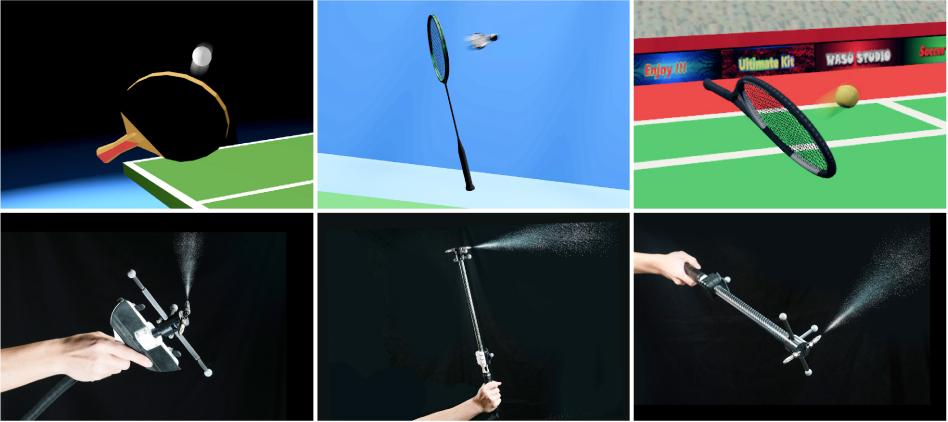AirRacket: Researches Use Air to Simulate Haptic Feedback in VR Sports
Over the past few years, researchers and engineers have come up with a gazillion ideas on how to simulate haptic feedback in virtual reality to improve the immersion in VR and AR experiences. In fact, haptic feedback will be an integral component of the metaversal experience. If VR is going to be an everyday part of our lives, including in our lifestyle and workplace, it has to simulate the sensations that we already feel in the real world such as touch, force feedback, smell, temperature, wind, and so forth. A team of researchers has now come up with a haptic feedback mechanism where a racket grip drilled out with a compressed air nozzle has been designed to enhance the feel of the ball in virtual racket sports such as VR tennis.

The researchers call their haptic feedback system AirRacket and describe it as perceptual modeling and design for an ungrounded and directional force feedback system for use in virtual racket sports. The system makes use of compressed air propulsion jets to generate the directional impact forces. AirRacket has been designed for three popular racket sports: tennis, badminton, and ping pong.
Current virtual reality controllers can provide an impressive simulation of racket sports in VR. This often works seamlessly for racket sports with gentler ball touches such as tennis and badminton. It also works for golf.

However, virtual reality simulations do not capture subtleties such as the angle of impact or the hardness that athletes will feel in the real world and intuitively factor into their game. For racket sports involving harder and larger balls such as baseball and tennis, the athlete will also not feel the power of the strike in virtual reality simulations.
AirRacket Using Compressed Air for Realistic Haptic Feedback
The researchers at the National Taiwan University in Taipei who are behind the AirRacket want to recreate the complex haptics and the powerful force involved in racket sports by using a fine-grained air pressure simulation. To realize this, the researchers attached an air pressure nozzle to a generic extendable racket handle which, in virtual reality, is transformed into a racket that matches the sports.
A portable compressor in a backpack, forces compressed air up the nozzle when the virtual ball falls on the bat. Depending on how the racket is held, the air will be expelled in different directions enabling the system to simulate the ball’s impact angle.
To provide tracking functions in the racket, an Optitrack system was attached to the tip of the handle. A Vive tracker can also be used to track but it is heavy. The air nozzle model is widely used in paintball guns.
The researchers wanted to simulate racket games like badminton, table tennis, and tennis and they are hoping to improve these games in virtual reality by providing a better ball feel. The first tests have shown that the system could improve both precision and immersion in the three racket sports.
The immersion from the system also works due to an optical trick. The force that a player sees in virtual reality, particularly the duration of the impact, creates the feeling of a perceived force with four times the strength of the force that actually comes from the nozzle.
However, the researchers’ compressor implementation could be too complex for home uses although it could find uses in location-based VR arcades or in professional training use-cases to increase the impact of the training and quality of immersion.
The researchers have also worked on other 3D printable grips for other sports including squash, golf, baseball, field hockey, and swords.
Find more information along with code downloads of the AirRacket haptic system on GitHub.
Sources: Research Paper
https://virtualrealitytimes.com/2022/05/13/airracket-researches-use-air-to-simulate-haptic-feedback-in-vr-sports/https://virtualrealitytimes.com/wp-content/uploads/2022/05/AirRacket-System-600x267.jpghttps://virtualrealitytimes.com/wp-content/uploads/2022/05/AirRacket-System-150x90.jpgGamingHapticsHardwareTechnologyOver the past few years, researchers and engineers have come up with a gazillion ideas on how to simulate haptic feedback in virtual reality to improve the immersion in VR and AR experiences. In fact, haptic feedback will be an integral component of the metaversal experience. If VR is...Sam OchanjiSam Ochanji[email protected]EditorVirtual Reality Times - Metaverse & VR
